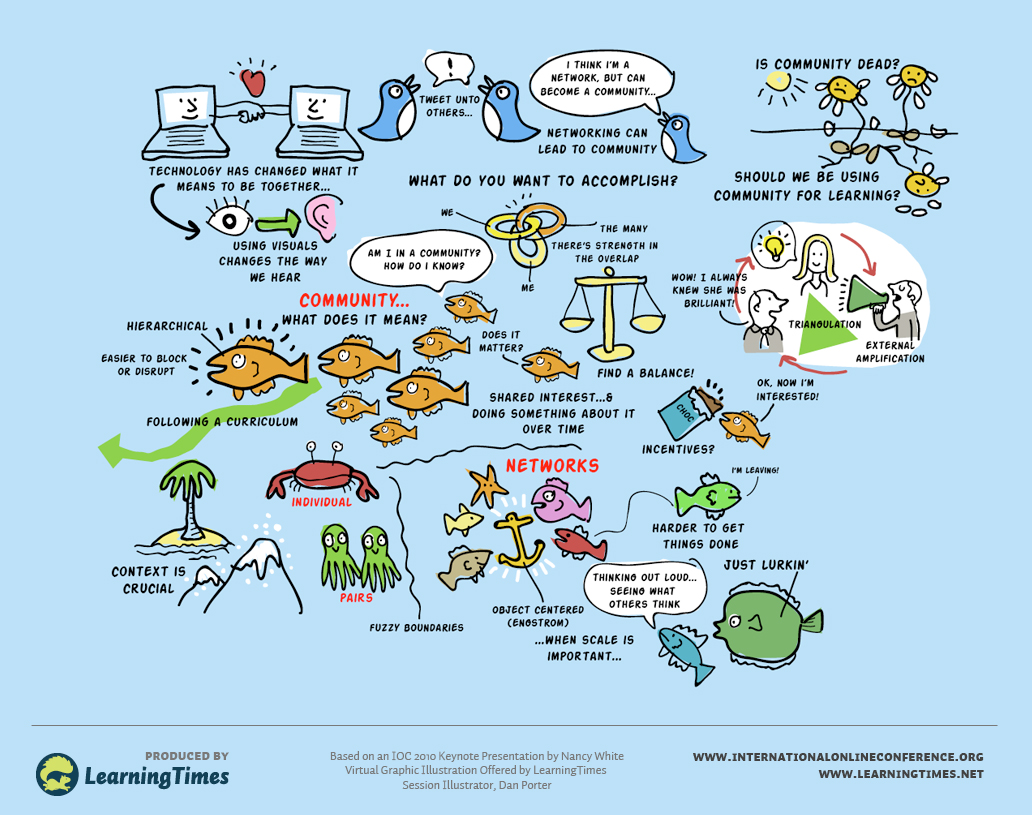Today I did a kick off talk at the International Online Conference 2010 (aka #IOC2010) on the “me-we-network” continuum, pegged with the semi-provocative question, “Should we be using communities in learning.” My main point was to put on the table the value of distinguishing the types of human configurations we can use, how they vary and why we shouldn’t lump them all under the generic and oft-misunderstood term “community.” Before the experience fades from memory I wanted to jot a few reflections.
This was a fully online live event using Elluminate with the cracker jack Learningtimes team behind the scenes. Shortly before the talk they let me know that they were going to have a virtual graphic facilitator scribing, live, visible via application sharing while I talked. They didn’t know I also do graphic facilitation — and was thrilled. Here we were, jumping off the cliff of learning and experimentation again. YAY!
First, if you are interested in the talk, the slides and artifacts are here. Second, if you are interested in my reflections on our process of weaving the talk, slides and scribing, read on and scroll to the bottom of the post to see the fabulous work of Dan Porter of Scriberia and the new LearningTimes in-house Virtual Graphic Facilitator! It is really beautiful. We watched for another 45 minutes after the talk ended to watch Dan rearrange objects in the image, add captions and color. He said he was using a large touch screen monitor. Waaay cool. Debrief after the picture!
nancy-communities-ioc2010.jpg (JPEG Image, 1032×815 pixels).

After the talk some of the 110 participants stayed logged in. The facilitation team first went to a break out room to debrief, but we quickly realized that a debrief with the remaining folks would be useful. We shared a few of our reflections then had some useful feedback from a handful of participants.
During the talk, I stopped to both read the chat room more closely and look at Dan’s emerging image, as much as for me, as to give the rest of the folks a rest from my typical break-neck presentation pace. In retrospect, I would have cut about 15-20% of my content to do this reflection piece with the visuals more deliberately and give more time/space for that very reflection. Jonathan Finkelstein noted that Elluminate, while it devolves a ton of control to the individual, actually made it harder to help people move and resize windows to either see both the slides and the application sharing. So if they did not “get” that process quickly, they may have felt stuck missing one or the other. One person reported seeing only the drawing and thus was confused with some of the things I said which were meant to complement an image on my slides. (I use mostly photographs and images with just a few words.) Another felt a bit overwhelmed trying to visually process both, but also said it was interesting. (A cliff jumper like me?)
Remembering back to last month’s live integration of Twitter in a F2F presentation, I also realized that I could have scaffolded the visual participation – again by reducing some content and using some small activity up front to help transition into the multiple visible options.
At this point Dan was wrapping up his visualization work and joined the conversation, adding a bit of the technical how-tos (responding to some participant queries). We talked about options of him chiming in, but he decided since this was a fairly new practice of scribing live online, he’d just scribe. We talked about how cool it was to compare the electronic scribing to our offline paper/chalk/pen work. Electronically you can move objects, clone, resize and color – things that are pretty darn hard with paper!
Dan will be scribing Friday’s keynote and will again be doing it for another LearningTimes facilitated event, this time with the Smithsonian (it looks very interesting! “Problem Solving With Smithsonian Experts” online, free, in April. Check it out. ). We agreed it would be fun to reconvene and debrief again after these events to consider what we learned as presenters, scribers and participants in live online events.
People like David Sibbet and Nancy Margulies have been doing amazing work with this as well. If you are interested, do check out their work.
Finally, related to the visual part of this post is a useful video from David Sibbett which brings home some of the points about the importance of both the visual and the kinesthetic in our learning — something we need to weave into our online work. TEDxSoMa – David Sibbet – 1/22/10.
Thanks to Dan and the Learningtimes folks for walking the edge together today at IOC2010!